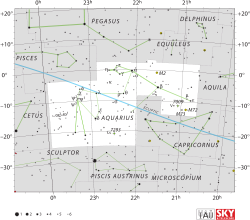Omicron Aquarii
| Observation data Epoch J2000 Equinox J2000 | |
|---|---|
| Constellation | Aquarius |
| Right ascension | 22h 03m 18.84403s[1] |
| Declination | –02° 09′ 19.3067″[1] |
| Apparent magnitude (V) | +4.71[2] |
| Characteristics | |
| Spectral type | B7 IVe[3] |
| U−B color index | –0.39[2] |
| B−V color index | –0.11[2] |
| Variable type | γ Cas[4] |
| Astrometry | |
| Radial velocity (Rv) | +11.0[5] km/s |
| Proper motion (μ) | RA: +24.66[1] mas/yr Dec.: –11.16[1] mas/yr |
| Parallax (π) | 7.49 ± 0.23 mas[1] |
| Distance | 440 ± 10 ly (134 ± 4 pc) |
| Absolute magnitude (MV) | −0.89[6] |
| Details | |
| Radius | 4.3[7] R☉ |
| Luminosity | 340[6] L☉ |
| Surface gravity (log g) | 3.13[8] cgs |
| Temperature | 13,464 ± 164[7] K |
| Metallicity [Fe/H] | −0.16[6] dex |
| Rotational velocity (v sin i) | 282 ± 20[9] km/s |
| Other designations | |
| Database references | |
| SIMBAD | data |
Omicron Aquarii, Latinized from ο Aquarii, is the Bayer designation for a star in the equatorial constellation of Aquarius. Visible to the naked eye, it has an apparent visual magnitude of +4.71.[2] Parallax measurements put it at a distance of roughly 440 light-years (130 parsecs) from Earth.[1]
It has the traditional star name Kae Uh, from the Chinese 蓋屋 (Mandarin pronunciation Gài Wū).[11] In Chinese astronomy, 蓋屋 is the rooftop, an asterism consisting of ο Aquarii and 32 Aquarii.[12] Consequently, the Chinese name for ο Aquarii itself is 蓋屋一 (Gài Wū yī, Template:Lang-en.)[13]
The spectrum of Omicron Aquarii fits a stellar classification of B7 IVe;[3] the luminosity class of IV suggests that this is a subgiant star that is exhausting the supply of hydrogen at its core and is in the process of evolving into a giant star. The 'e' suffix on the class indicates that the spectrum shows emission lines of hydrogen, thus categorizing this as a Be star. Omicron Aquarii is rotating rapidly with a projected rotational velocity of 205 km/s.[14] The rotation rate along the equator may be as high as 77% of the critical rotation velocity, with the axis of rotation being inclined by around 70° ± 20°. The emission lines are being generated by a decreted circumstellar disk of hot hydrogen gas.[9]
It is classified as a Gamma Cassiopeiae type[4] variable star and its brightness varies from magnitude +4.68 to +4.89.[15]
References
- ^ a b c d e f van Leeuwen, F. (November 2007), "Validation of the new Hipparcos reduction", Astronomy and Astrophysics, 474 (2): 653–664, arXiv:0708.1752, Bibcode:2007A&A...474..653V, doi:10.1051/0004-6361:20078357, S2CID 18759600.
- ^ a b c d Feinstein, A.; Marraco, H. G. (November 1979), "The photometric behavior of Be Stars", Astronomical Journal, 84: 1713–1725, Bibcode:1979AJ.....84.1713F, doi:10.1086/112600.
- ^ a b Lesh, Janet Rountree (December 1968). "The Kinematics of the Gould Belt: an Expanding Group?". Astrophysical Journal Supplement. 17: 371. Bibcode:1968ApJS...17..371L. doi:10.1086/190179.
- ^ a b "omi Aqr", General Catalogue of Variable Stars, Sternberg Astronomical Institute, retrieved 2012-07-03. Note: type = GCAS.
- ^ Wielen, R.; et al. (1999), "Sixth Catalogue of Fundamental Stars (FK6). Part I. Basic fundamental stars with direct solutions", Veroeffentlichungen des Astronomischen Rechen-Instituts Heidelberg, 35 (35), Astronomisches Rechen-Institut Heidelberg: 1, Bibcode:1999VeARI..35....1W.
- ^ a b c Anderson, E.; Francis, Ch. (2012), "XHIP: An extended hipparcos compilation", Astronomy Letters, 38 (5): 331, arXiv:1108.4971, Bibcode:2012AstL...38..331A, doi:10.1134/S1063773712050015, S2CID 119257644.
- ^ a b Underhill, A. B.; et al. (November 1979), "Effective temperatures, angular diameters, distances and linear radii for 160 O and B stars", Monthly Notices of the Royal Astronomical Society, 189 (3): 601–605, Bibcode:1979MNRAS.189..601U, doi:10.1093/mnras/189.3.601.
- ^ Soubiran, C.; Le Campion, J.-F.; Cayrel de Strobel, G.; Caillo, A. (June 2010), "The PASTEL catalogue of stellar parameters", Astronomy and Astrophysics, 515: A111, arXiv:1004.1069, Bibcode:2010A&A...515A.111S, doi:10.1051/0004-6361/201014247, S2CID 118362423.
- ^ a b Meilland, A.; Millour, F.; Kanaan, S.; Stee, Ph.; Petrov, R.; Hofmann, K.-H.; Natta, A.; Perraut, K. (February 2012), "First spectro-interferometric survey of Be stars. I. Observations and constraints on the disk geometry and kinematics", Astronomy & Astrophysics, 538: A110, arXiv:1111.2487, Bibcode:2012A&A...538A.110M, doi:10.1051/0004-6361/201117955, S2CID 64777633.
- ^ "omi Aqr". SIMBAD. Centre de données astronomiques de Strasbourg. Retrieved 2012-07-03.
- ^ Allen, R. H. (1963), Star Names: Their Lore and Meaning (Reprint ed.), New York: Dover Publications Inc, p. 53, ISBN 0-486-21079-0, retrieved 2010-12-12.
- ^ (in Chinese) 中國星座神話, written by 陳久金. Published by 台灣書房出版有限公司, 2005, ISBN 978-986-7332-25-7.
- ^ (in Chinese) AEEA (Activities of Exhibition and Education in Astronomy) 天文教育資訊網 2006 年 5 月 16 日
- ^ Abt, Helmut A.; Levato, Hugo; Grosso, Monica (July 2002), "Rotational Velocities of B Stars", The Astrophysical Journal, 573 (1): 359–365, Bibcode:2002ApJ...573..359A, doi:10.1086/340590.
- ^ Ruban, E. V.; et al. (September 2006), "Spectrophotometric observations of variable stars", Astronomy Letters, 32 (9): 604–607, Bibcode:2006AstL...32..604R, doi:10.1134/S1063773706090052, S2CID 121747360.

